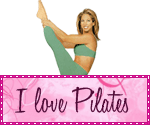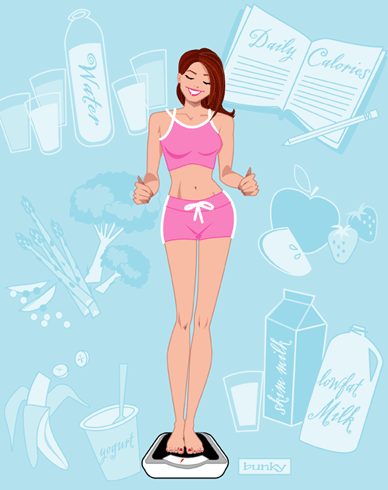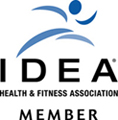
From left to right the above photo shows:
A. Ideal Alignment, B. Kyphosis-Lordosis, C. Flat-Back, D. Sway-Back
Kyphotic-Lordodic Body Type.
- Kyphosis is when your thoracic spine has increased flexion. Think of this as being rounded in your upper back (thoracic spine). In an accelerated version, you will see people like my little mama who have the little hunched over back.
- Lordosis basically means you have too much extension or hyperextension in your lumbar region/lower back.
- Forward Head (cervical spine/neck region extended).
- Abducted Scapulae (which helps to create that rounded look).
- Anterior Pelvis Tilt which can cause the belly to pooch .
- Hyperextension in the knee joints.
- Slight Plantar Ankle Joints.
Is that a mouth full, or what?
What do we do for this body type in Pilates?
As in all body types, we work to bring the body into neutral by applying exercises designed just for that particular body type. I'm going to detail this type as it does seem to bear many challenges. Some of the other posture types will have similar challenges.
Forward Head: Most all types have a forward head which causes misalignment of the cervical spine, extending beyond its neutral position. Is it any wonder why some of us have neck and head aches? We are a progressive people always in the mode of going what direction? Forward. We have the tendency to lean forward. We are like a dart heading to its target. The challenge is to bring the head back on top of the body.
Homework: Have someone take a picture of you from the side (and do not correct your posture or you will defeat the purpose). Remember most people have forward heads. Look at yourself in that photo. Now think about correcting your cervical spine (neck area) out of extension or flexion. Put your head on top of your body. Quit wearing it like it’s disconnected from your body! And while bringing it back to the top, think of someone pulling (gently, of course) you up from the top of your head…lengthen, lengthen the neck. My trainer used to take my pony-tail on top of my head and give me a little pull; it helped me “feel” what I needed to work toward. Chiropractic adjustments may help a forward head as well. However, I believe simple awareness makes all the difference in the world.
Kyphotic Back: A major emphasis for this type is opening up the chest and getting out of rounded shoulders. There are many exercises on and off of the equipment that are very helpful. Extension is a key to get out of an unhealthy amount of flexion in the upper thoracic. I love to work off the stability ball in a prone position while performing Breast Stroke Preps to open up the chest. It's critical to begin to correct the kyphosis immediately. The longer you wait, the more difficult your recovery is going to be.
Homework: From the side, take a look at your upper back without correcting your normal stance. If you are rounded over, think of standing up taller like someone is pulling you up from the top of your head. Don’t lean forward. Quit crunching your ribs together; they do NOT like it. They were not made to stay smashed together. Next, think of moving your shoulders not just back, but BACK and DOWN. Let them glide/slide back and down. Though this may be uncomfortable for you at first, it does get easier. You have to remember you have misinformed your muscles. Now that you are speaking a new language to them, they don’t want to be bothered. Ultimately they'll love it. The health benefits will begin, and as an added feature you will look xtra beautiful. Wow! And your body will thank you.
Anterior Pelvis: Posterior, Anterior? You may be asking what in the world does all that mean? Posterior means you are tilting from the back toward the front, while an anterior tilt is the opposite. From the front tilting to the back (note above graphic). When you do both? U R Elvis the Pelvis! Please, no! Your goal is to find neutral where your pelvis is level and square. Otherwise you will have issues that may travel up and down your body. ouch.
Homework: When you stand from the side without correcting, notice how your tush is positioned (the tilt of the pelvis will affect the look of your tush). Now if you have a more rounded booty, you will have to have someone help you look past your cute booty patooty. Why? Because we don't look for flesh/skin but bones and bony landmarks and a rounded tush may give the appearance of an anterior tilt. Anyway, does it look like your tush is pushing toward the back or the front? Finding neutral means not tilting anteriorly or posteriorly; it's finding an in between point. Why is it important? For one thing it keeps you out of your hip joints…keeping you from flexing or extending them too much. Also, it keeps your belly from going in directions it was not made to…like out (note above graphic).
Travel down to the knee joint. Hopefully, you will have a nice neutral knee. I don't. I hyperextend. When assessing someones knees we look at the position of the patella/knee cap from the side, front, and back. That's a simple explanation, but we'll let that suffice for now. Are the knees level, are they shifting laterally, medially, are they knock-kneed, or hyperextended, are the legs bowed, etc.. Again, anything outside of neutral will create issues in other parts of the body. Again, take a look at the above graphic. Notice the knee position in the Sway and Flat-Back Postures.
Homework: If when you stand in profile stance, you see your knees pressing into the back of your knee joint, you are hyperextending. The goal is to soften the knee ever so slightly. Don’t push back into the knee. We watch how the knee tracks when teaching Pilates whether on the mat or equipment. Again mental awareness is the key. I hyperextend my knee joints, so I have to make a mental note and adjust accordingly. Ex: when I am standing in the ck-out line at grocery store, I find myself pushing back into my knees because it feels comfy…but it’s horrible for my posture/body/health. As far as "shifting" knees, knock-knees, etc., we have to address those issues individually.
The feet. In the near future I will be posting a series on those slighted creatures. They bare a great burden every day of our lives, and we give them so little thought. OK, with this body type we often see a slight plantar extension in the ankle. The body shifts with every incorrect position we put our bodies in. Yes, even the feet. Footwork is at the front end of what we teach clients in Pilates. The Reformer is one of the best places to begin. I teach clients how to do footwork with props they have at home when they don't have access to equipment. We look at whether the feet are rolling out or inward. Where are they in space, besides the floor! Are the toes pointing toward or away from each other? Everted or inverted? Do they go different directions? Ex.: I have a client who has one foot that points almost sideways. Which has caused back and hip issues. Again, these are just some of the questions we use in analysis.
Homework: Take a gander at the sole of your shoes. Do you see wearing on certain sides of your shoes? Maybe on one shoe more than the other? Walk in place for a few seconds, then stop. Look down and take notice of where your feet are in space. Far apart? Close together? Is one foot angled differently from the other foot? Or are they both even? Are you sinking and or putting more weight on the outside of your feet or the inside? How about those little piggies? Are they together or far apart or jumping in all different directions? Are you pigeon toed...feet turning inward? Do they turn outward? What is your ankle up to? Is it moving forward toward the top of your foot or falling away from it? Again, you want to wear neutral.
As in all body types, we work to bring the body into neutral by applying exercises designed just for that particular body type. I'm going to detail this type as it does seem to bear many challenges. Some of the other posture types will have similar challenges.
Forward Head: Most all types have a forward head which causes misalignment of the cervical spine, extending beyond its neutral position. Is it any wonder why some of us have neck and head aches? We are a progressive people always in the mode of going what direction? Forward. We have the tendency to lean forward. We are like a dart heading to its target. The challenge is to bring the head back on top of the body.
Homework: Have someone take a picture of you from the side (and do not correct your posture or you will defeat the purpose). Remember most people have forward heads. Look at yourself in that photo. Now think about correcting your cervical spine (neck area) out of extension or flexion. Put your head on top of your body. Quit wearing it like it’s disconnected from your body! And while bringing it back to the top, think of someone pulling (gently, of course) you up from the top of your head…lengthen, lengthen the neck. My trainer used to take my pony-tail on top of my head and give me a little pull; it helped me “feel” what I needed to work toward. Chiropractic adjustments may help a forward head as well. However, I believe simple awareness makes all the difference in the world.
Kyphotic Back: A major emphasis for this type is opening up the chest and getting out of rounded shoulders. There are many exercises on and off of the equipment that are very helpful. Extension is a key to get out of an unhealthy amount of flexion in the upper thoracic. I love to work off the stability ball in a prone position while performing Breast Stroke Preps to open up the chest. It's critical to begin to correct the kyphosis immediately. The longer you wait, the more difficult your recovery is going to be.
Homework: From the side, take a look at your upper back without correcting your normal stance. If you are rounded over, think of standing up taller like someone is pulling you up from the top of your head. Don’t lean forward. Quit crunching your ribs together; they do NOT like it. They were not made to stay smashed together. Next, think of moving your shoulders not just back, but BACK and DOWN. Let them glide/slide back and down. Though this may be uncomfortable for you at first, it does get easier. You have to remember you have misinformed your muscles. Now that you are speaking a new language to them, they don’t want to be bothered. Ultimately they'll love it. The health benefits will begin, and as an added feature you will look xtra beautiful. Wow! And your body will thank you.
Anterior Pelvis: Posterior, Anterior? You may be asking what in the world does all that mean? Posterior means you are tilting from the back toward the front, while an anterior tilt is the opposite. From the front tilting to the back (note above graphic). When you do both? U R Elvis the Pelvis! Please, no! Your goal is to find neutral where your pelvis is level and square. Otherwise you will have issues that may travel up and down your body. ouch.
Homework: When you stand from the side without correcting, notice how your tush is positioned (the tilt of the pelvis will affect the look of your tush). Now if you have a more rounded booty, you will have to have someone help you look past your cute booty patooty. Why? Because we don't look for flesh/skin but bones and bony landmarks and a rounded tush may give the appearance of an anterior tilt. Anyway, does it look like your tush is pushing toward the back or the front? Finding neutral means not tilting anteriorly or posteriorly; it's finding an in between point. Why is it important? For one thing it keeps you out of your hip joints…keeping you from flexing or extending them too much. Also, it keeps your belly from going in directions it was not made to…like out (note above graphic).
Travel down to the knee joint. Hopefully, you will have a nice neutral knee. I don't. I hyperextend. When assessing someones knees we look at the position of the patella/knee cap from the side, front, and back. That's a simple explanation, but we'll let that suffice for now. Are the knees level, are they shifting laterally, medially, are they knock-kneed, or hyperextended, are the legs bowed, etc.. Again, anything outside of neutral will create issues in other parts of the body. Again, take a look at the above graphic. Notice the knee position in the Sway and Flat-Back Postures.
Homework: If when you stand in profile stance, you see your knees pressing into the back of your knee joint, you are hyperextending. The goal is to soften the knee ever so slightly. Don’t push back into the knee. We watch how the knee tracks when teaching Pilates whether on the mat or equipment. Again mental awareness is the key. I hyperextend my knee joints, so I have to make a mental note and adjust accordingly. Ex: when I am standing in the ck-out line at grocery store, I find myself pushing back into my knees because it feels comfy…but it’s horrible for my posture/body/health. As far as "shifting" knees, knock-knees, etc., we have to address those issues individually.
The feet. In the near future I will be posting a series on those slighted creatures. They bare a great burden every day of our lives, and we give them so little thought. OK, with this body type we often see a slight plantar extension in the ankle. The body shifts with every incorrect position we put our bodies in. Yes, even the feet. Footwork is at the front end of what we teach clients in Pilates. The Reformer is one of the best places to begin. I teach clients how to do footwork with props they have at home when they don't have access to equipment. We look at whether the feet are rolling out or inward. Where are they in space, besides the floor! Are the toes pointing toward or away from each other? Everted or inverted? Do they go different directions? Ex.: I have a client who has one foot that points almost sideways. Which has caused back and hip issues. Again, these are just some of the questions we use in analysis.
Homework: Take a gander at the sole of your shoes. Do you see wearing on certain sides of your shoes? Maybe on one shoe more than the other? Walk in place for a few seconds, then stop. Look down and take notice of where your feet are in space. Far apart? Close together? Is one foot angled differently from the other foot? Or are they both even? Are you sinking and or putting more weight on the outside of your feet or the inside? How about those little piggies? Are they together or far apart or jumping in all different directions? Are you pigeon toed...feet turning inward? Do they turn outward? What is your ankle up to? Is it moving forward toward the top of your foot or falling away from it? Again, you want to wear neutral.
The body is screaming for balance.
NEXT: Sway Back Posture, Part Five of Body Adjustment/Awareness Series





 Enjoy
Enjoy











